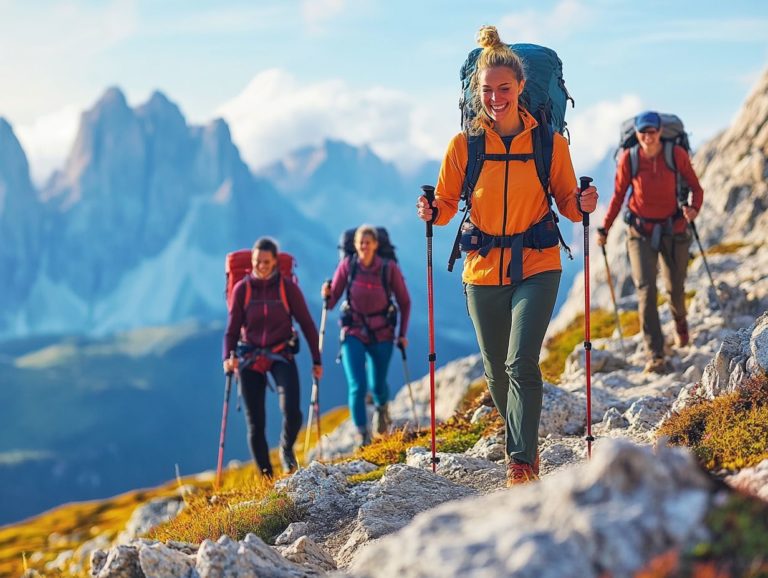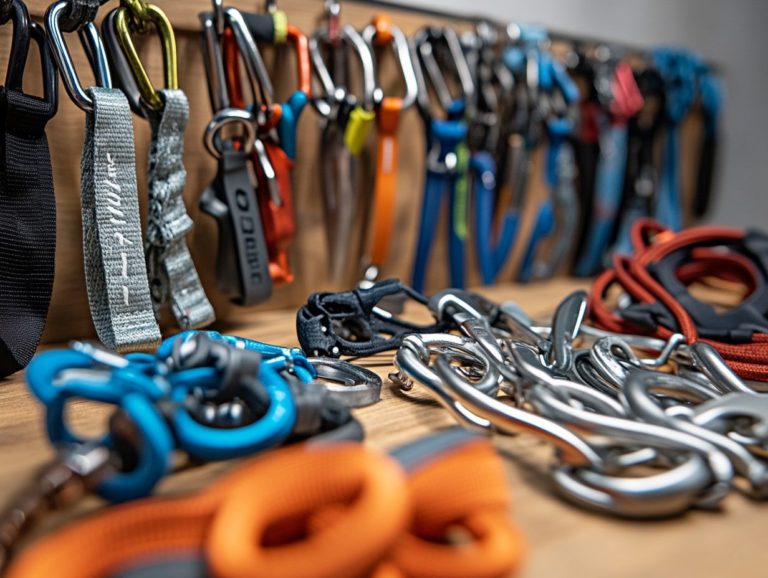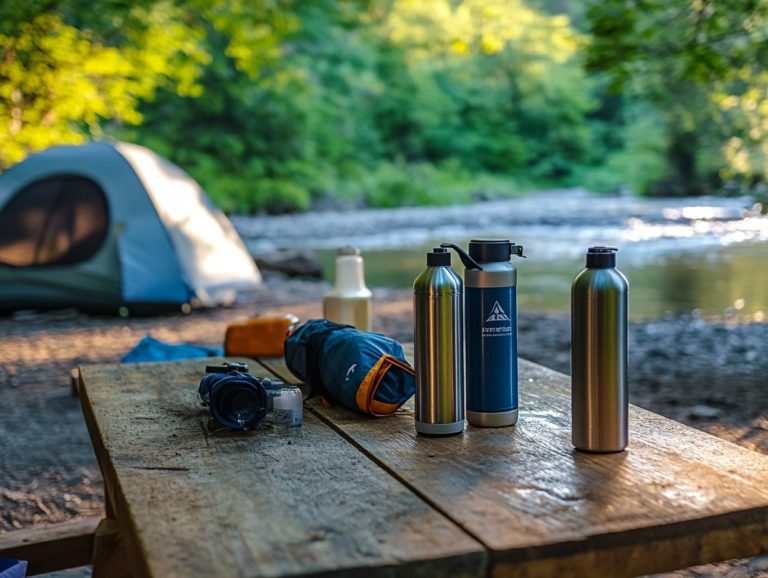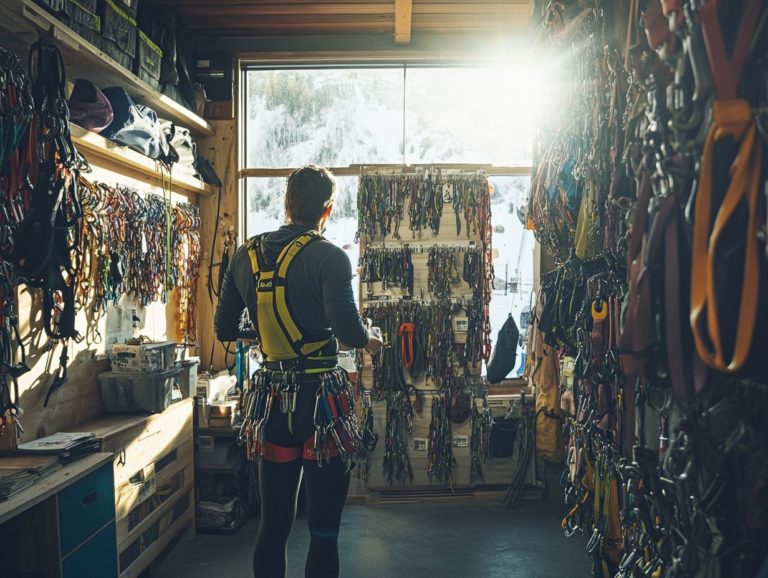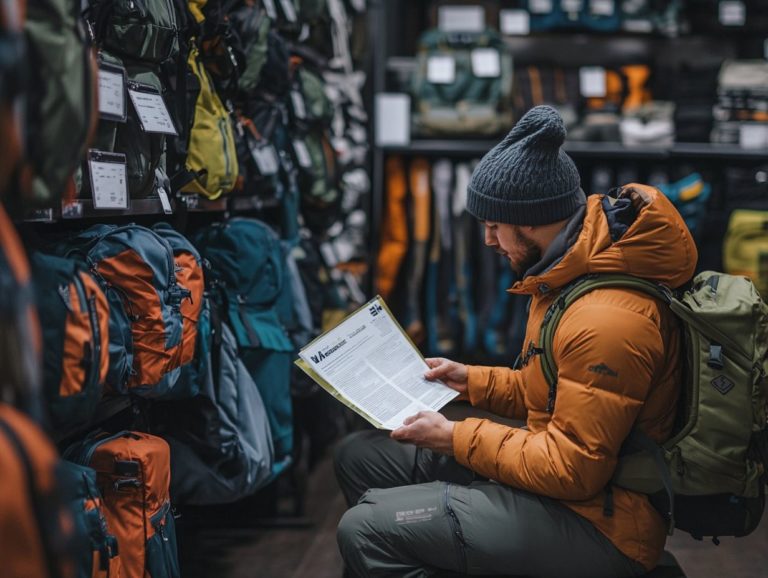What to Know About Climbing Shoes?
Choosing the right climbing shoes is essential for both your performance and safety on the rock face. With a plethora of styles and features at your disposal, understanding how to select the ideal pair can truly enhance your climbing experience.
This guide delves into the various types of climbing shoes, highlighting the critical factors to consider for achieving the perfect fit. You ll also find valuable tips for proper care and maintenance. It addresses common mistakes to steer clear of, ensuring you maximize the benefits of your gear.
Whether you re a seasoned climber or just embarking on your journey, this comprehensive guide offers insights tailored for everyone.
Contents
Key Takeaways:
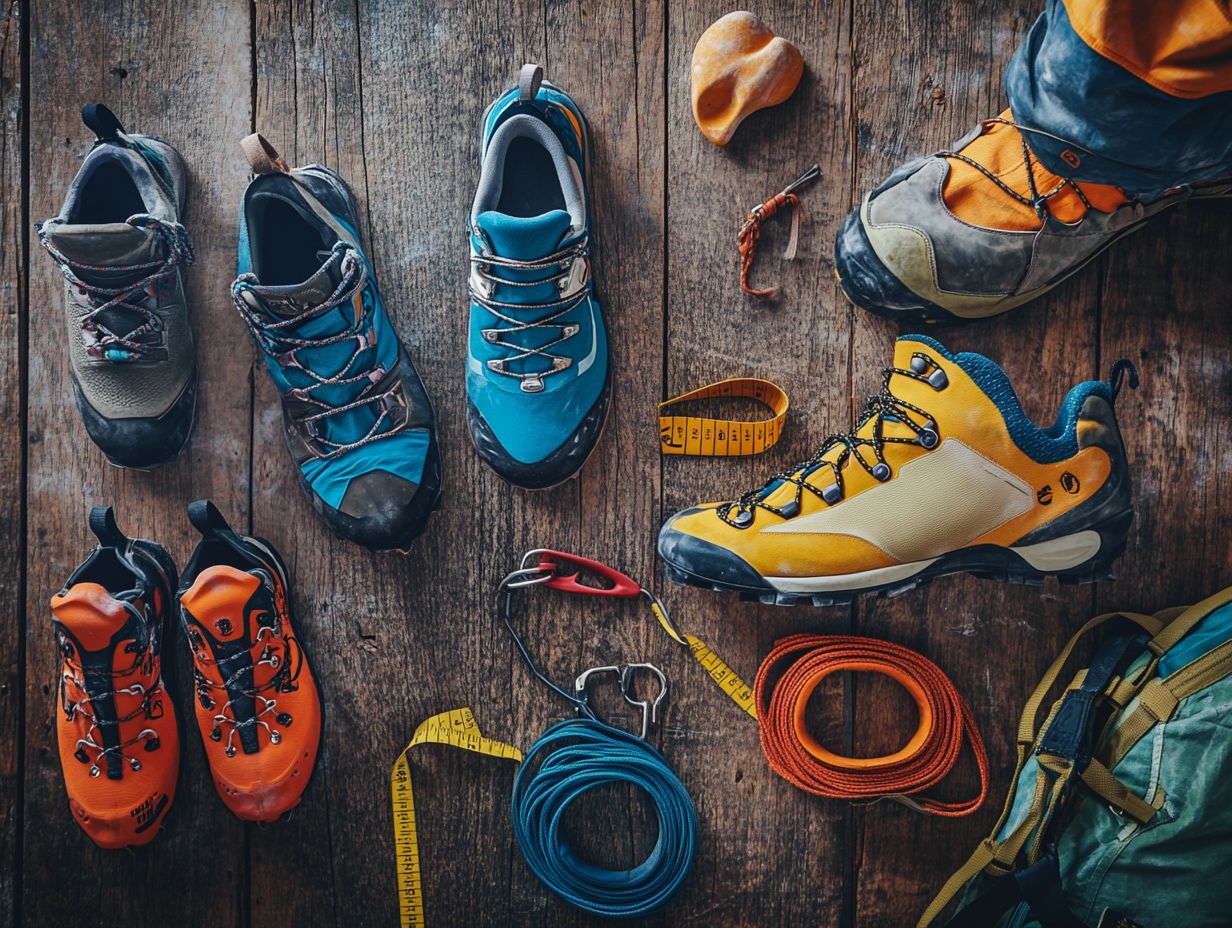
- Choosing the right climbing shoes can supercharge your performance on the wall!
- Different climbing styles require different shoe types. Consider the design that best fits your needs.
- When choosing climbing shoes, carefully consider fit, material, and features to ensure a comfortable and effective climb.
The Importance of Choosing the Right Climbing Shoes
Selecting the perfect climbing shoes is essential for maximizing both performance and comfort. They significantly enhance your climbing experience, whether you’re scaling indoor walls or navigating outdoor terrains.
The right fit and features can dramatically impact your climbing techniques. This allows you to tackle a range of climbing styles and routes with confidence. Contemporary climbing shoes use advanced materials tailored for various climbing profiles and environments. This makes your choice all the more critical, whether you’re a novice or a seasoned pro.
How Climbing Shoes Affect Performance
Climbing shoes play a pivotal role in your climbing performance, as their features enhance grip, support, and precision in foot placements.
These elements are crucial when considering the various climbing techniques and styles you might use. For example, your choice of how the shoes fasten whether Velcro or laces can significantly influence the fit. A proper fit allows you to focus on your technique instead of discomfort.
The design of the heel cup is vital for heel hooking performance, providing the security needed during those dynamic moves. Additionally, the toe position is essential; a downturned shoe enables greater precision on small footholds, enabling you to maintain stability and efficiency key factors when tackling challenging routes.
Types of Climbing Shoes
Climbing shoes come in a variety of types, each crafted to suit specific climbing styles and individual preferences, such as neutral, moderate, and aggressive profiles. Grasping these distinctions is crucial as you refine your climbing techniques. Each shoe type offers unique advantages in terms of performance, comfort, and foot support.
Don’t wait! Choosing the right climbing shoe can profoundly elevate your climbing experience. Whether you re a novice in search of a more forgiving fit or an experienced climber aiming for precision on steep ascents, the right choice is vital.
Different Designs for Different Climbing Styles
Different climbing styles demand specific shoe designs to truly optimize your performance. Aggressive climbing shoes are perfect for steep, technical ascents, while moderate climbing shoes provide the versatility needed for multipitch routes.
The subtleties in these shoe designs cater to both the terrain and your individual preferences and foot shape. For instance, a shoe with a pointed toe helps you step precisely on small footholds, aiding in control and balance during challenging maneuvers. Furthermore, the choice between Velcro and laces for closure significantly influences how easily you can adjust your fit and secure your shoes.
A snug fit is crucial; it allows you to transmit power effectively while minimizing the risk of blisters. By understanding how shoe characteristics interact with your climbing techniques, you can make informed choices that enhance your effectiveness on the rock.
Get out there and choose the perfect pair of climbing shoes to take your skills to new heights!
Factors to Consider When Choosing Climbing Shoes
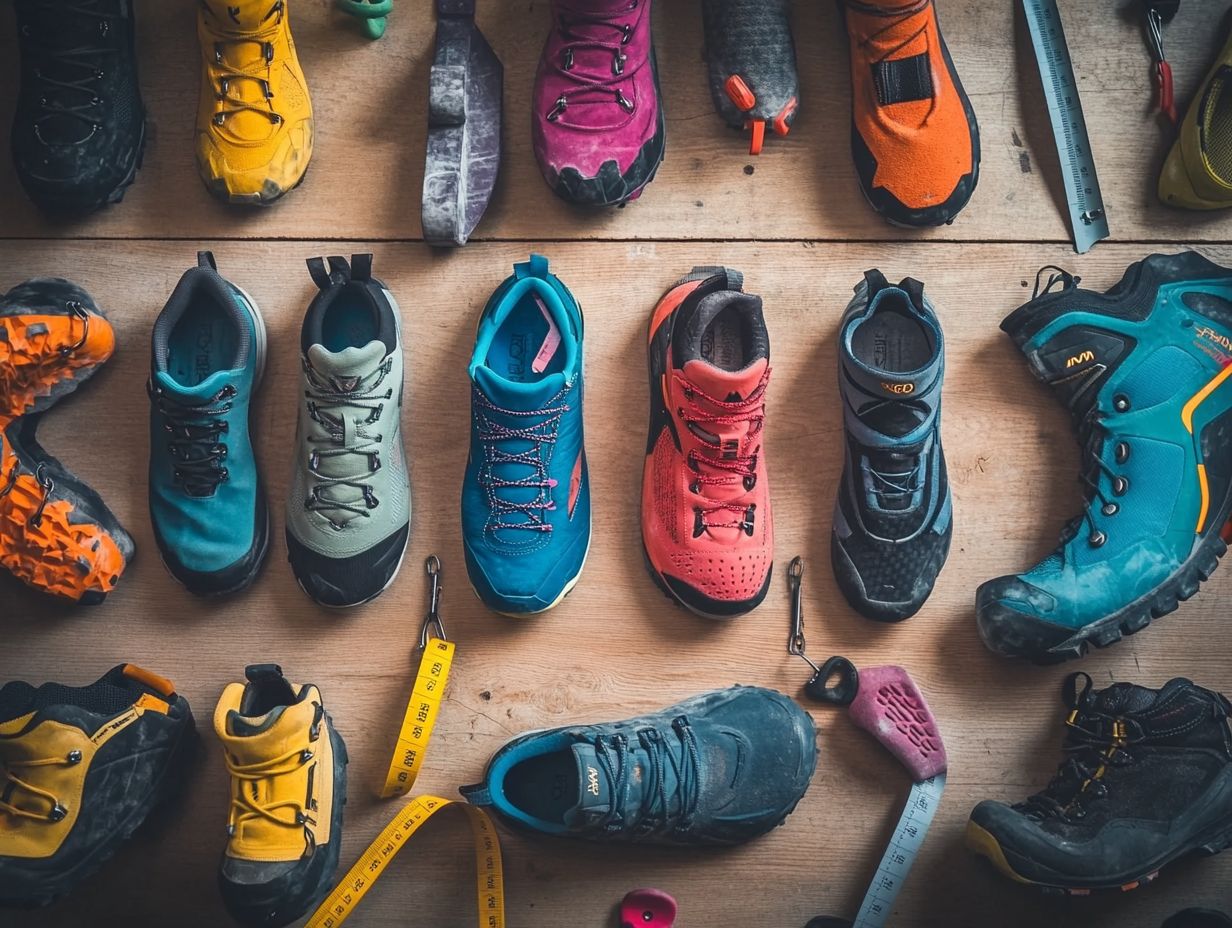
When you re choosing climbing shoes, it s essential to consider several key factors. The fit, materials, and features are all critical elements that directly influence your performance and comfort on the rock or wall.
Each aspect plays a significant role in ensuring that your climbing experience is both enjoyable and effective.
Fit, Material, and Features
The fit of your climbing shoes is absolutely paramount. A snug yet comfortable fit can truly elevate your climbing experience.
The choice of materials plays a crucial role in durability and comfort as well. Synthetic materials often provide a lighter, more breathable option, making them perfect for climbers who prioritize comfort during those long ascents.
Conversely, leather shoes may offer superior durability and mold to your foot over time, creating a personalized fit that many climbers swear by.
The balance between fit and material directly impacts your performance. A shoe that fits well and incorporates high-tech features, such as rubber outsoles for enhanced grip, can significantly boost your confidence on challenging routes.
Ultimately, finding the right combination can elevate both your comfort and climbing effectiveness, ensuring that each ascent is as enjoyable as it is rewarding.
How to Properly Fit Climbing Shoes
Ensuring that your climbing shoes fit properly is crucial for optimizing your performance, comfort, and safety. The right size and fit not only prevent discomfort but also enhance your footwork precision on those challenging routes.
Tips for Finding the Perfect Fit
Let s discover how to find the climbing shoes that will unleash your potential! Finding the perfect climbing shoes is all about understanding your foot shape and trying on different sizes.
Consider how the shoe will perform with your climbing techniques. It s essential to assess how the shoes feel while standing, bending, and even crouching.
These positions will help you uncover any potential pressure points and movement restrictions. The choice of materials whether synthetic or leather can greatly affect how well the shoe lets air in and overall comfort during your climbs.
Keep in mind that climbing shoes may stretch over time, so starting with a snug fit is essential for improving your performance as they break in.
By experimenting with different models and paying close attention to foot support, you can elevate your overall experience and performance on the rock face.
Caring for Your Climbing Shoes
Caring for your climbing shoes is essential for preserving their performance and extending their lifespan. This involves employing proper cleaning and storage techniques that are specifically suited to the materials of your shoes.
By doing so, you not only enhance their functionality but also ensure they remain in top condition for your next climbing adventure.
Maintenance and Cleaning Tips
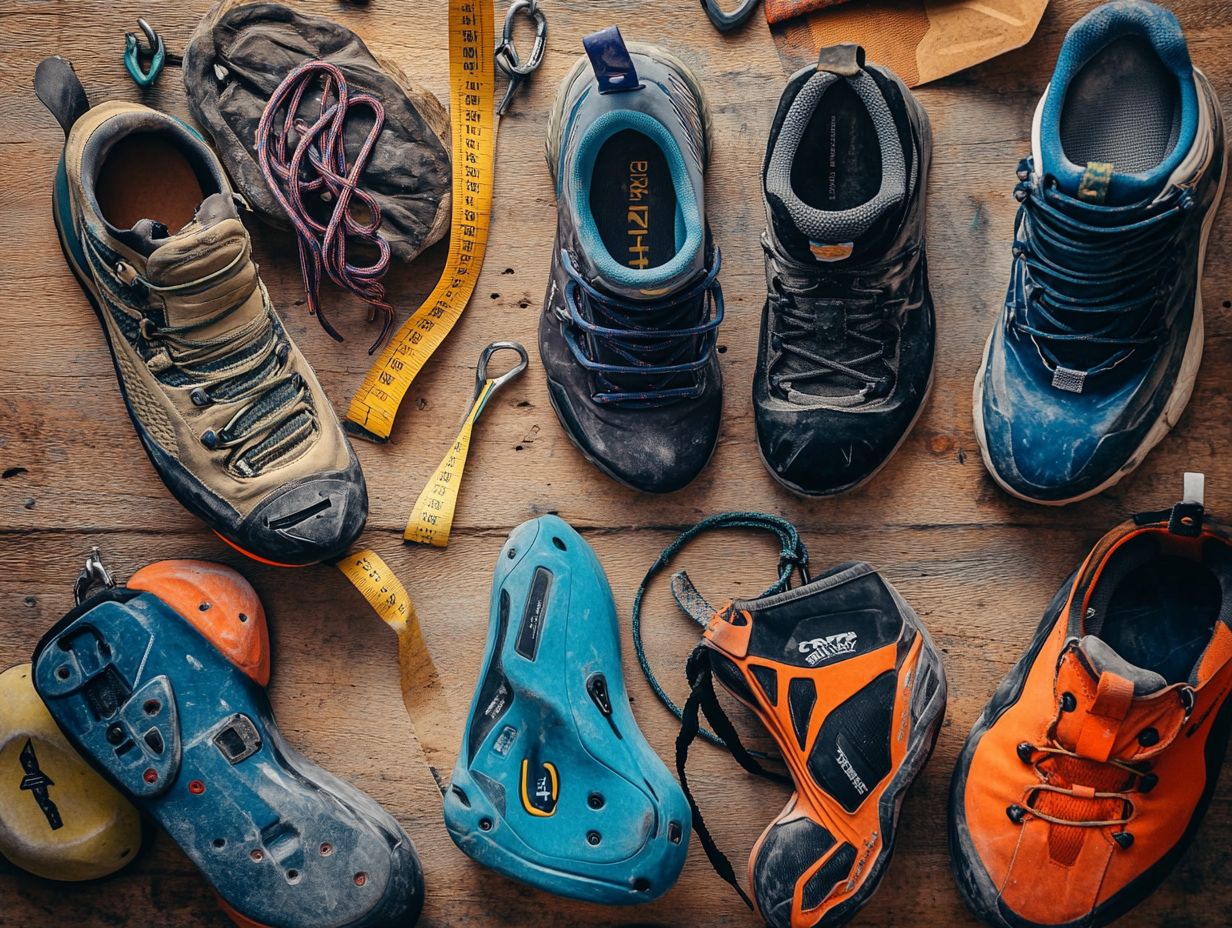
To ensure longevity and optimal performance, your climbing shoes require regular maintenance, including using appropriate cleaning methods tailored to their specific materials.
Employing effective cleaning techniques not only preserves the integrity of the shoe but also enhances your grip and comfort on the rock.
For synthetic climbing shoes, a gentle scrub with a soft brush and warm soapy water will effectively remove accumulated dirt and sweat. Remember to air dry them away from direct sunlight to prevent material degradation.
On the other hand, leather climbing shoes require a more specialized approach. After cleaning, applying a conditioner will keep the leather supple and resilient, ensuring it molds perfectly to your foot for an unparalleled fit.
Ultimately, consistent upkeep is essential for maintaining performance and maximizing the life of these vital pieces of climbing gear.
Common Mistakes to Avoid When Using Climbing Shoes
Avoiding common mistakes with your climbing shoes is crucial for preventing injuries and maximizing your performance. This attention to detail allows you to concentrate on refining your climbing techniques and styles, enhancing your overall experience on the rock.
Don’t wait! The right shoes can transform your climbing experience today!
Take care of your gear, and it will take care of you on your next adventure!
Preventing Injuries and Maximizing Performance
Preventing injuries while maximizing your climbing performance requires a keen focus on shoe fit, choosing the right materials, and understanding how each detail influences your technique.
Your safety as a climber hinges significantly on choosing the right footwear. The right shoes not only offer essential support but also enhance your grip and stability on various surfaces. By selecting shoes crafted from high-quality materials, you ensure long-lasting durability and optimal performance.
For example, opting for shoes with a rubber sole can provide superior traction. A snug fit minimizes the risk of blisters and foot injuries. Regularly check your footwear and replace them when needed to strike the perfect balance between comfort and functionality.
Finding this balance is vital for your safety and performance!
Frequently Asked Questions
What to Know About Climbing Shoes?
Climbing shoes are an essential piece of gear for any rock climber. They offer the necessary support and grip for safely scaling vertical surfaces. Here are 6 common questions and answers to help you understand what to know about climbing shoes.
What are the different types of climbing shoes?
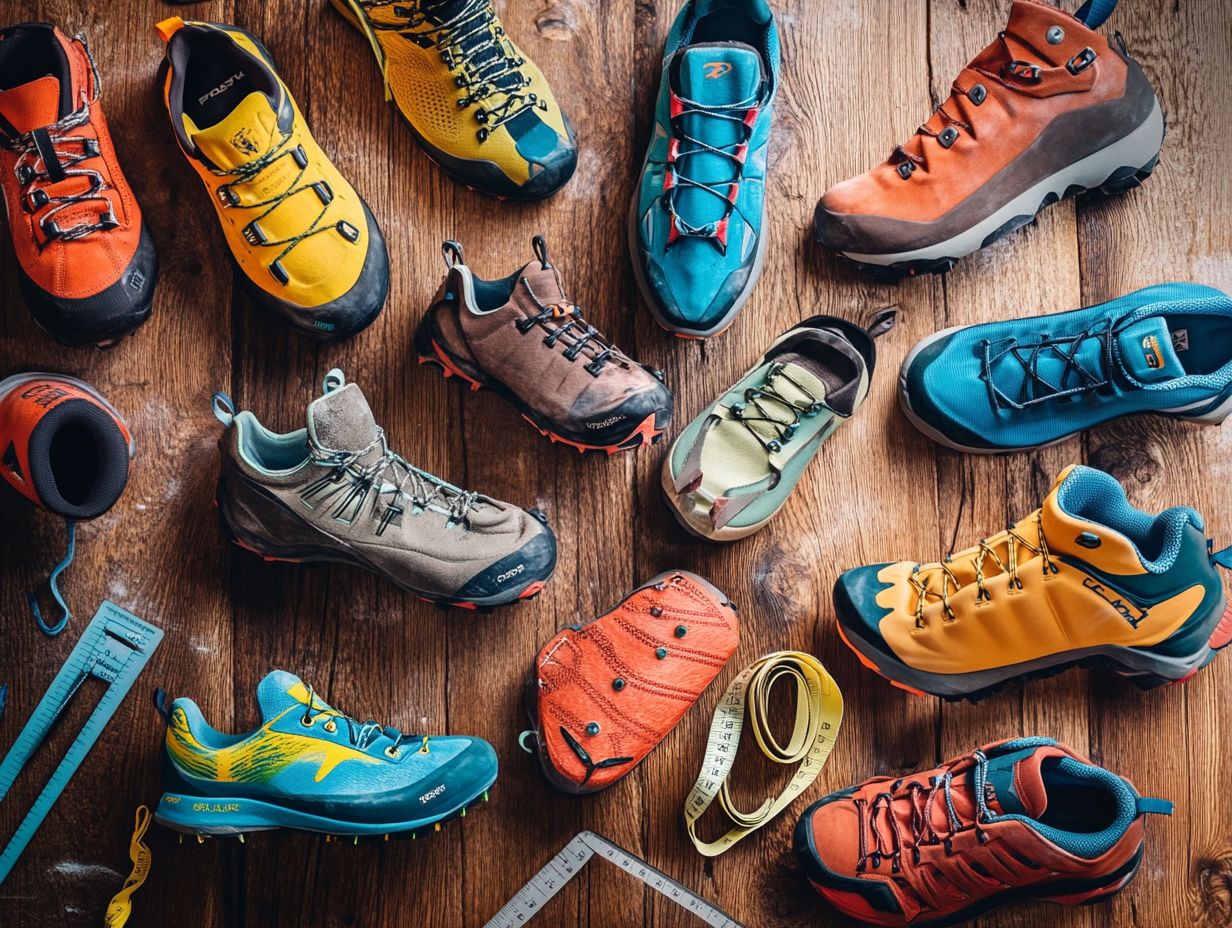
There are three main types of climbing shoes: neutral, moderate, and aggressive. Neutral shoes are best for beginners and provide a comfortable fit with a flat sole. Moderate shoes have a slight curve in the sole and are better for intermediate climbers. Aggressive shoes have a significant curve and are best for advanced climbers tackling difficult routes.
What features should I consider when choosing climbing shoes?
Some important features to consider include fit, closure system, and rubber type. A good fit is crucial for comfort and performance. The closure system is how the shoes fasten on your feet, which can be laces, straps, or slip-on, and should provide a snug fit. Lastly, the type of rubber used on the sole can affect the shoe’s grip and durability.
Can I use the same climbing shoes for indoor and outdoor climbing?
Absolutely! You can rock the same climbing shoes for both indoor and outdoor adventures. However, some climbers prefer to have separate shoes for each environment, as the terrain and types of holds may differ. It s a good idea to have a more durable pair for outdoor climbing, as the rocks can be rougher on the shoes.
How often should I replace my climbing shoes?
The lifespan of climbing shoes can vary depending on usage and care. Generally, they should be replaced every 6 months to a year if you climb regularly. Signs it’s time for a new pair include significant wear on the sole or a loss of grip. It’s best to replace them before they become unsafe or uncomfortable to wear.
Are there any special care instructions for climbing shoes?
Yes! Taking good care of your climbing shoes can prolong their lifespan. Avoid leaving them in direct sunlight, as it can cause the rubber to break down. It’s also important to keep them clean and dry after each use. Some climbers recommend rotating between two pairs to give them time to air out and prevent odor.
Can I use climbing shoes for other activities besides rock climbing?
While climbing shoes are primarily designed for rock climbing, they can also be used for other activities like bouldering, slacklining, and even parkour. Some climbers use them for weightlifting or sports that require good grip and foot support. However, they may not be suitable for activities involving a lot of lateral movement.
Ready to find the perfect climbing shoes? Let s get you climbing safely and efficiently!

